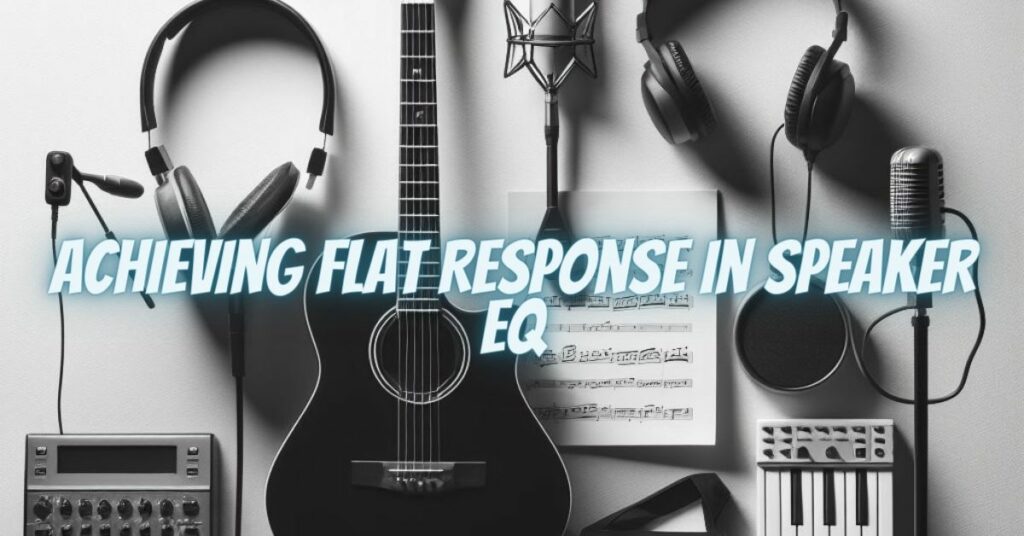Achieving a flat frequency response in your speakers is a critical goal for audio professionals, music enthusiasts, and anyone who values accurate, uncolored sound reproduction. A flat response means that the speakers reproduce audio in a balanced and neutral manner, without exaggerating or attenuating specific frequencies. In this article, we will explore the process of EQing speakers to achieve a flat response, the tools and techniques involved, and the benefits of this sonic fidelity.
Understanding Flat Frequency Response
A flat frequency response means that the speakers accurately reproduce all frequencies across the audio spectrum without any significant boosts or cuts in specific ranges. This results in a faithful representation of the original audio source, ensuring that what you hear is as close as possible to what was recorded or intended by the artist.
Tools and Equipment
To EQ speakers for flat response, you’ll need the following tools and equipment:
- Measurement Microphone: A high-quality measurement microphone is crucial for accurately assessing the speaker’s response. It captures the audio signal and sends it to a measurement system.
- Measurement System: You’ll need a measurement system or software, such as Room EQ Wizard (REW) or SMAART, to analyze the frequency response of your speakers.
- Equalization Processor: An equalization processor or a digital signal processor (DSP) is used to apply corrective EQ to the audio signal.
- Reference Tracks: High-quality reference tracks in a variety of musical genres are essential for evaluating the effectiveness of your EQ adjustments.
Steps to EQ Speakers for Flat Response
- Room Analysis: Start by analyzing your listening environment. The room’s acoustics can significantly impact the speaker’s response. Note any acoustic issues, such as standing waves or reflections.
- Positioning: Ensure that your speakers are placed correctly within the room. Avoid placing them too close to walls or corners, as this can lead to bass buildup. Experiment with speaker placement to optimize the response.
- Calibrate the Measurement Microphone: Calibrate your measurement microphone using the provided calibration file to ensure accurate measurements.
- Measurement: Use your measurement system to capture the frequency response of the speakers in their current setup. This will help you identify any deviations from a flat response.
- Frequency Response Analysis: Analyze the measurement data to identify peaks and dips in the frequency response. These deviations are the areas that need correction.
- Apply EQ Corrections: Use your equalization processor or DSP to apply corrective EQ settings. The goal is to reduce or boost specific frequencies to achieve a flat response.
- Multiple Measurements: Perform several measurements at various listening positions in the room to ensure that your EQ adjustments work consistently across different locations.
- Reference Tracks: Play reference tracks through your speakers to evaluate their performance. Ensure that they sound balanced and natural, as you’d expect in a well-tuned system.
- Fine-Tuning: Continue to fine-tune the EQ settings, making incremental adjustments as needed to achieve the flattest response possible. This process may require multiple iterations.
Benefits of Flat Response
Achieving a flat response in your speakers offers several benefits:
- Accurate Sound Reproduction: A flat response ensures that the audio you hear is a faithful representation of the original source, making it ideal for critical listening and audio production.
- Balanced Mixes: If you’re a music producer or engineer, a flat response allows you to create balanced mixes that translate well to other playback systems.
- Reduced Listener Fatigue: A flat response minimizes listening fatigue since you’re not exposed to exaggerated or attenuated frequencies that can strain your ears.
- Consistency: With a flat response, your audio system’s performance remains consistent across different listening positions in the room.
EQing speakers for flat response is an essential process for achieving sonic fidelity and accurate sound reproduction. By carefully analyzing your room’s acoustics, taking precise measurements, and making informed EQ adjustments, you can ensure that your speakers faithfully reproduce audio with minimal coloration or distortion. Whether you’re a professional audio engineer, a music producer, or a dedicated audiophile, the pursuit of a flat response will elevate your listening and production experiences to new levels of sonic clarity and precision.

